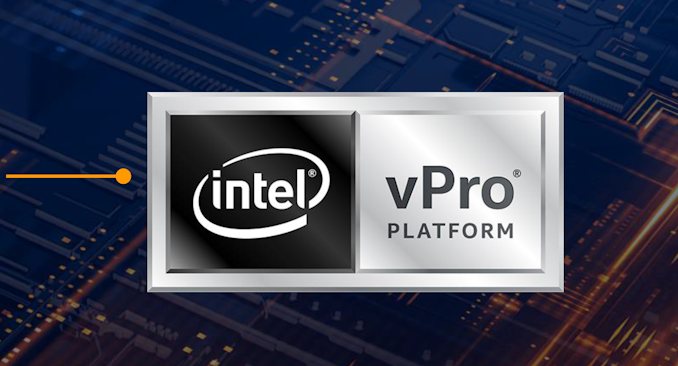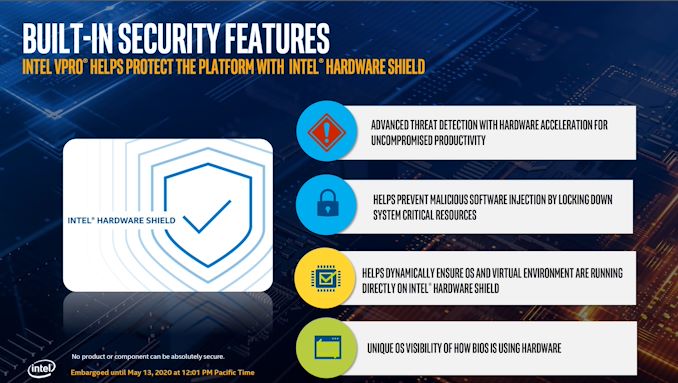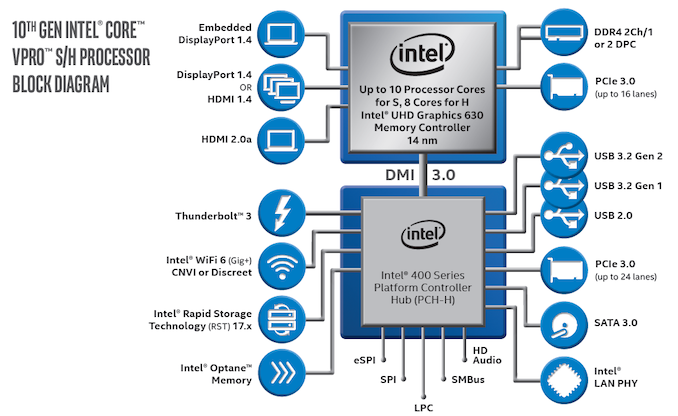With every launch of desktop processors, Intel typically follows it up with a series of vPro enabled parts in order for the company to provide solutions through its partners to business customers that require extra levels of manageability and security. This is all part of Intel’s SIPP (Stable IT Platform Program), with security features such as Intel Hardware Shield, and manageability though Intel Endpoint Management Assistant. The new hardware will offer up to 10 cores on desktop and 8 cores on mobile. One poignant part of the announcement is that when asked, Intel stated that 400-series chipsets will be supported. When asked for confirmation, Intel repeated this line, indicating that vPro now goes beyond traditional Qx70 motherboard support and a fundamental shift in Intel’s vPro paradigm.
Intel’s new 10th Gen Comet Lake vPro processors come in three flavors: mobile, desktop, and workstation, with the latter being part of another announcement for today, the launch of the new Xeon W-1200 product family. All of these processors at heart contain the same Comet Lake silicon we’ve seen launched in other 10th Gen product lines for consumers, however various additional features that were disabled in those parts are enabled here. In the past Intel used to offer separate SKU lines for the processors, but now they are named one and the same. Customers will have to look out for ‘Intel vPro Support’ listed in the product description in order to determine if the product has it.
Starting with the mobile CPUs, most of these are H-series class, meaning 45 W, but a few will be 15 W as well.
| Intel 10th Gen Comet Lake vPro Mobile Processors |
|||||||
| AnandTech | Cores | Base Freq |
Turbo TB2 |
Turbo TB3 |
Turbo TVB |
TDP | IGP |
| H-Series | |||||||
| i9-10855H | 8C/16T | 2.4 | 5.3? | ? | ? | 45 W | 630 |
| i7-10875H | 8C/16T | 2.3 | 5.1? | ? | ? | 45 W | 630 |
| i7-10850H | 6C/12T | 2.7 | 5.1? | ? | ? | 45 W | 630 |
| i5-10400H | 4C/8T | 2.6 | 4.6? | ? | ? | 45 W | 630 |
| W-10885M | 8C/16T | 2.4 | 5.3? | ? | ? | 45 W | 630 |
| W-10855M | 6C/12T | 2.8 | 5.1? | ? | ? | 45 W | 630 |
| U-Series | |||||||
| i7-10810U | 6C/12T | 1.1 | 4.9? | ? | ? | 15 W | 630 |
| i7-10610U | 4C/8T | 1.8 | 4.9? | ? | ? | 15 W | 630 |
| i5-10310U | 4C/8T | 1.7 | 4.4? | ? | ? | 15 W | 630 |
We’re still waiting on extra data that wasn’t provided in our briefings, however these CPUs will support similar features to the consumer counterparts, including the extra vPro add-ins.
On the desktop, we get some surprises:
| Intel 10th Gen Comet Lake vPro Desktop Processors |
|||||||||
| AnandTech | Cores | Base Freq |
TB2 1C |
TB2 nT |
TB3 1C |
TVB 1C |
TVB nT |
TDP | IGP |
| Core i9 with vPro | |||||||||
| i9-10900K | 10C/20T | 3.7 | 5.1 | 4.8 | 5.2 | 5.3 | 4.9 | 125 | 630 |
| i9-10900 | 10C/20T | 2.8 | 5.0 | 4.5 | 5.1 | 5.2 | 4.6 | 65 | 630 |
| i9-10900T | 10C/20T | 1.9 | 4.5 | 3.7 | 4.6 | - | - | 35 | 630 |
| Core i7 with vPro | |||||||||
| i7-10700K | 8C/16T | 3.8 | 5.0 | 4.7 | 5.1 | - | - | 125 | 630 |
| i7-10700 | 8C/16T | 2.9 | 4.7 | 4.6 | 4.8 | - | - | 65 | 630 |
| i7-10700T | 8C/16T | 2.0 | 4.4 | 3.7 | 4.5 | - | - | 35 | 630 |
| Core i5 with vPro | |||||||||
| i5-10600K | 6/12 | 4.1 | 4.8 | 4.5 | - | - | - | 125 | 630 |
| i5-10600 | 6/12 | 3.3 | 4.8 | 4.4 | - | - | - | 65 | 630 |
| i5-10600T | 6/12 | 2.4 | 4.0 | 3.7 | - | - | - | 35 | 630 |
| i5-10500 | 6/12 | 3.1 | 4.5 | 4.2 | - | - | - | 65 | 630 |
| i5-10500T | 6/12 | 2.3 | 3.8 | 3.5 | - | - | - | 35 | 630 |
There will be vPro versions of all the major processors, and they will all have integrated graphics. The big question mark is the fact that all the K versions of the CPUs are supported, however when asked why these are supported and about overclocking, Intel seemed confused and contradicted itself, stating that overclocking wasn’t on these CPUs. We’re not sure if there’s a communication mix-up there, or if it’s a chipset issue, which if all 400-series chipsets are supported here, then overclocking probably is as well.
It is worth noting that nothing below an i5 is supported for vPro. In the past Intel passed this off as the fact that anything i3 and below did not provide enough performance for the vPro customer. However, for those products in the past, vPro was on the quad-core processors, which for this generation would be the Core i3. So the fact that Core i3 isn’t supported here means the comments made in previous years were perhaps not the exact reason why i3 wasn’t supported then, and isn’t supported today.
The last section of supported processors are the new W-1200 family workstation parts:
| Intel 10th Gen Comet Lake vPro Workstation |
|||||||||
| AnandTech | Cores | Base Freq |
TB2 1C |
TB2 nT |
TB3 1C |
TVB 1C |
TVB nT |
TDP | IGP |
| Core i9 | |||||||||
| W-1290P | 10C/20T | 3.7 | ? | 4.8 | 5.2 | 5.3 | 4.9 | 125 | P630 |
| W-1290 | 10C/20T | 3.2 | ? | 4.6 | 5.1 | 5.2 | 4.7 | 80 | P630 |
| W-1290T | 10C/20T | 1.9 | ? | 3.8 | 4.7 | - | - | 35 | P630 |
| W-1270P | 8C/16T | 3.8 | ? | 4.7 | 5.1 | - | - | 125 | P630 |
| W-1270 | 8C/16T | 3.4 | ? | 4.7 | 5.0 | - | - | 80 | P630 |
| W-1250P | 6C/12T | 4.1 | ? | 4.5 | - | - | - | 125 | P630 |
| W-1250 | 6C/12T | 3.3 | ? | 4.4 | - | - | - | 80 | P630 |
Intel hasn’t really said much about these, but we’ll cover them in a different news segment. These use W480 motherboards, and are incompatible with the Z490 consumer motherboards.
Intel states that as part of the upgrades for vPro this generation, they have been working with Microsoft to give more administrative and security insight of the systems that they power. This includes AI-accelerated detection algorithms that run on the GPU to detect attacks on secure areas. This also means rolling back a BIOS to an uncompromised version, and when asked what would happen if the rollback BIOS has the same flaw, Intel stated that the new hardware shield elements, that operate below ring 0, would be able to disable parts of the core that could be attacked.
Chipset Support: All 400-Series Chipsets (?)
One of the question marks that hasn’t been answered at this time is chipset support. Historically vPro requires support of a very specific Q-series chipset, or a workstation/server chipset. For this launch, Intel has not made any announcements about new Q-series chipsets, so when asked what chipsets would be supported, we were simply told ‘400-series chipsets’. In the accompanying materials, we were given this diagram:
There is no mention to a Q470 chipset, so at this point we’re assuming that Intel does actually mean all 400-series chipsets are supported. This is paradigm shifting, perhaps to enable vPro to a wider market but also to allow for a wider range of support of different peripherals.
(It is worth noting that Thunderbolt 3 here still requires additional controller support (like any other PCIe attached device), and the Wi-Fi 6 CNVI support also requires the OEM to purchase Intel’s additional CRF module.)
Project Athena
Intel also announced that its vPro parts would be compatible with the Project Athena standards they are implementing with its partners. When asked what partners would be participating, Intel stated that they would wait for the partners to announce. Somewhat odd with this announcement and our briefing is that Intel didn’t actually mention any of its vPro partners, even holistically by name, or quotes about what partners think about Intel’s features.
The final word on Intel’s 10th Gen Comet Lake vPro line is that Intel is announcing it today, and we can tell you some details, however exact launch schedules or launch partners are unknown.
from AnandTech https://ift.tt/35XNzMO
via IFTTT



0 comments:
Post a Comment